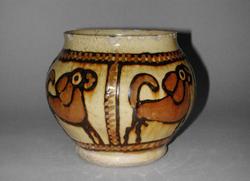Current Location: Gallery 27 (Glaisher)
Maker(s)
Production:
Unidentified Staffordshire Pottery
Entities
Categories
Description
Slip-coated earthenware, slip-trailed in two shades of brown with three hounds chasing a hare, each enclosed in a frame formed by pairs of horizontal and vertical lines and short strokes
Buff earthenware, thrown, with an applied strap handle, coated with white slip, and decorated in two shades of brown slip under yellowish lead-glaze; base unglazed. The bulbous pot stands on a thick disk base. Its sides contract into a very short neck with a slightly everted rim. The small strap handle is attached to one side. The sides are decorated with four panels outlined by pairs of dark brown horizontal and vertical lines with paler brown strokes over them. Three panels enclose a hound and one, a hare., all running to the right. On the outside of the handle there are short horizontal strokes in dark brown slip.
Notes
History note: Occupant of a cottage who sold it for £8 to a dealer in Kent or Sussex; sold to Mrs Hemming, 'Little Bundles' near Tonbridge Wells; purchased from her for £60 which was paid to Mr Hemming on 12 June 1925 by Dr J.W.L. Glaisher, FRS, Trinity College, Cambridge
Legal notes
Dr J. W. L. Glaisher Bequest
Measurements and weight
Height: 14.8 cm
Width: 20.8 cm
Acquisition and important dates
Method of acquisition: Bequeathed
(1928-12-07)
by
Glaisher, J. W. L., Dr
Dating
17th Century, Late
Charles II
James II
William III and Mary II
Circa
1670
CE
-
1700
CE
Note
Label text from the exhibition ‘Feast and Fast: The Art of Food in Europe, 1500–1800’, on display at The Fitzwilliam Museum from 26 November 2019 until 31 August 2020:One-handled honey pot with three hounds chasing a hare. This late seventeenth-century honey pot would, originally, have had a ceramic lid to keep dust and insects out. It is a rare survival as they were easily broken, which explains why many were made in wood. Honey was used for remedies for jaundice, worms, and piles and in recipes for gingerbread and mead.
Pots of this shape are often described as honey pots, but could have been used for other purposes
Components of the work
Visible Areas
composed of
lead-glaze
Decoration
composed of
slip
Rim
Diameter 13 cm
Materials used in production
Earthenware
Techniques used in production
Throwing
: Buff earthenware, thrown, coated in shite slip, decorated with slip trailing in two shades of brown slip, and lead-glazed, except for the base
Inscription or legends present
Inscription present: rectangular white paper label with cut corners
- Text: 4547/Slipware one-/handled posset/pot/having 3 dogs/and a hare in brown on a yellow/ground./Drawn in fig. 50 of/Rackham and/Reed./b. from Mrs Hem/ming (Tonbridge/Wells June 12/1925
- Location: On base
- Method of creation: Hand-written in black ink
- Type: Label
References and bibliographic entries
Related exhibitions
Identification numbers
Accession number: C.231-1928
Primary reference Number: 73333
Old object number: 4547
Stable URI
Audit data
Created: Saturday 6 August 2011
Updated: Friday 1 August 2025
Last processed: Friday 1 August 2025
Associated departments & institutions
Owner or interested party:
The Fitzwilliam Museum
Associated department:
Applied Arts







